Text: Peter Tepe | Section: Articles by Artists
Summary: Typewritten texts retrieved in an office clear-out have led to three artistic series. A previously compiled, fourth series, which is included here, also establishes a connection between science and art. Two of the series belong to the category science-related art, whilst the other two are assigned to art-related science.
In 2019, in the course of an all-too-often postponed office clear-out, I sifted through my lecture papers on philosophy and German studies, as well as documents on my own research/publications that had been stored in around 50 boxes, several office containers and a filing cabinet. Much of this material was quickly discarded and the rest will be re-organised in a new way – which is bound to take some time. My findings from the clear-out motivated me to create three new series of works on paper, whose concepts I will explain in the following. Another series, which I already started at the end of 2018, will also be considered.
Series 1: Typewritten script of a lecture
Up until the end of the 1990s, I used a typewriter not only to write my own texts, but also to copy out excerpts from specialist literature I was using for my own research projects. I started out with a mechanical typewriter before switching to an electric one. Unlike the excerpts, my own texts (for seminars, lectures, talks, essays, books) were created in multiple stages; this is evident from the fact that they consist of easily recognisable layers. New sentences and paragraphs were later glued in – a procedure not uncommon at the time. Texts that emerged from complex research processes sometimes show five or more such layers; preparations for lectures presenting research results, on the other hand, usually generated no more than two to three layers.
Series 1 pertains to the typewritten script, retrieved during my clear-out, that I compiled for the lecture Myth – Ideology – Illusion (Mythos – Ideologie – Illusion), held at the conference Philosophy and Mythology (Philosophie und Mythologie) on 26 and 27 November 1994 in Schwerte. The text was subsequently published in the volume Mythologica 3.[1] I have subjected several of the inserted typewritten pages to a free artistic process, whereby I accentuate various features: in some of these works, the goal is to highlight the various layers of the original text; in others, the lecture notes remain at least partially legible, and so on.


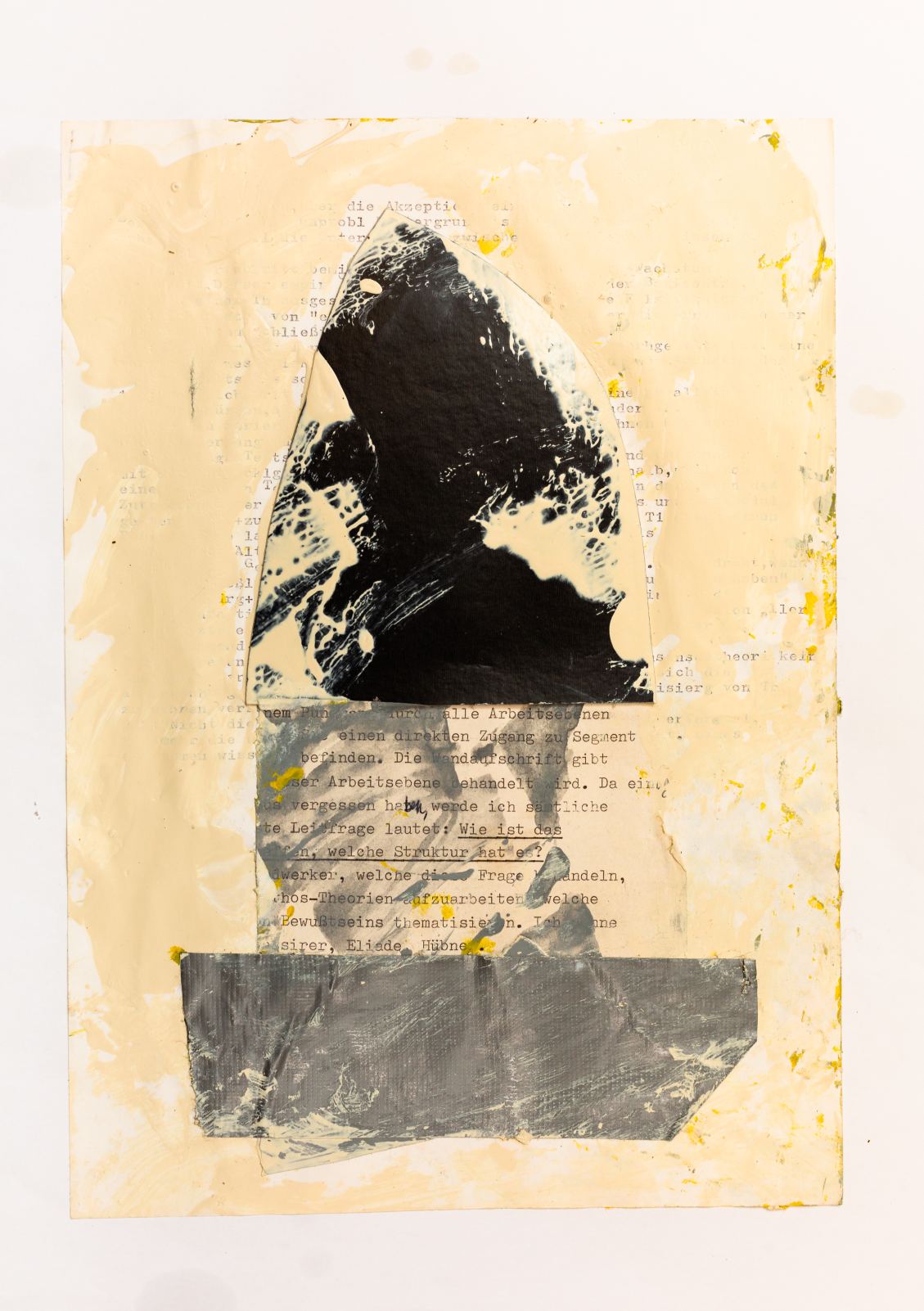
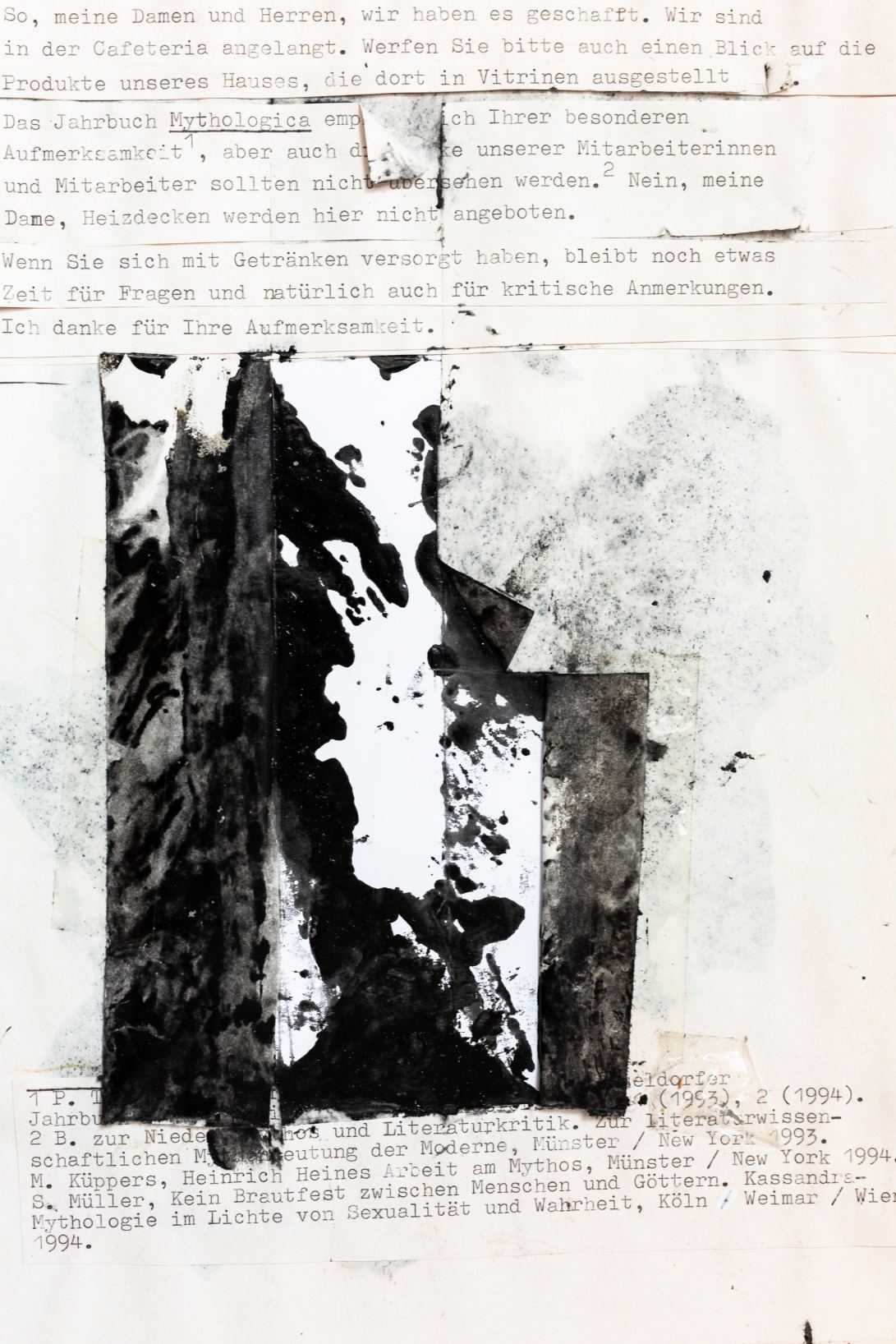
So far, series 1 consists of 12 works in A4 format and is classified as science-related art: in my free artistic process I have drawn on lecture notes in which I presented fields of work from the interdisciplinary research topic Myth, Ideology (the add-on and methods came in the late 1990s) to a specialist audience.
Series 2: Material from the dialogical lectures
In the winter semester 1993/94, the lecture The Mythical, the All-Too Mythical (Mythisches, Allzumythisches) took place; the world’s first and presumably only lecture in theatrical form to date – the w/k article Vorlesungstheater goes into full detail about this. Afterwards, I held lectures over several semesters that were a little less elaborate in the form of dialogues without acting scenes, but with artist guests.[2] During the clear-out I re-discovered typewritten texts I had completely forgotten about: all sorts of information for the lecture team (comprising Sabine Jambon, Yoshiro Nakamura, Susanne Stemmler, Ingo Toben and Helge May, who also served as director), dialogue drafts (of which I do not recall whether they were performed or scrapped) and much more besides. I regard these texts as historical documents which provide information on the procedure of the dialogical lectures. Therefore, in contrast to series 1, my aim was to keep the texts fully legible – apart from minimal work traces.
In series 2, I artistically reworked several findings as follows: in my studio I have preserved many remnants of earlier work processes. These I then use for the artistic conception of the pages, which occurs very quickly: according to game rules I have set myself, this operation should not take longer than 1–2 minutes and subsequent changes are not allowed. With regards to speed – but not concerning the concrete way of working – series 2 suggests a certain similarity with how my teacher Karl Otto Götz worked, who was also described as a speed painter (Sekundenmaler). This also applies to series 1 to a certain extent.



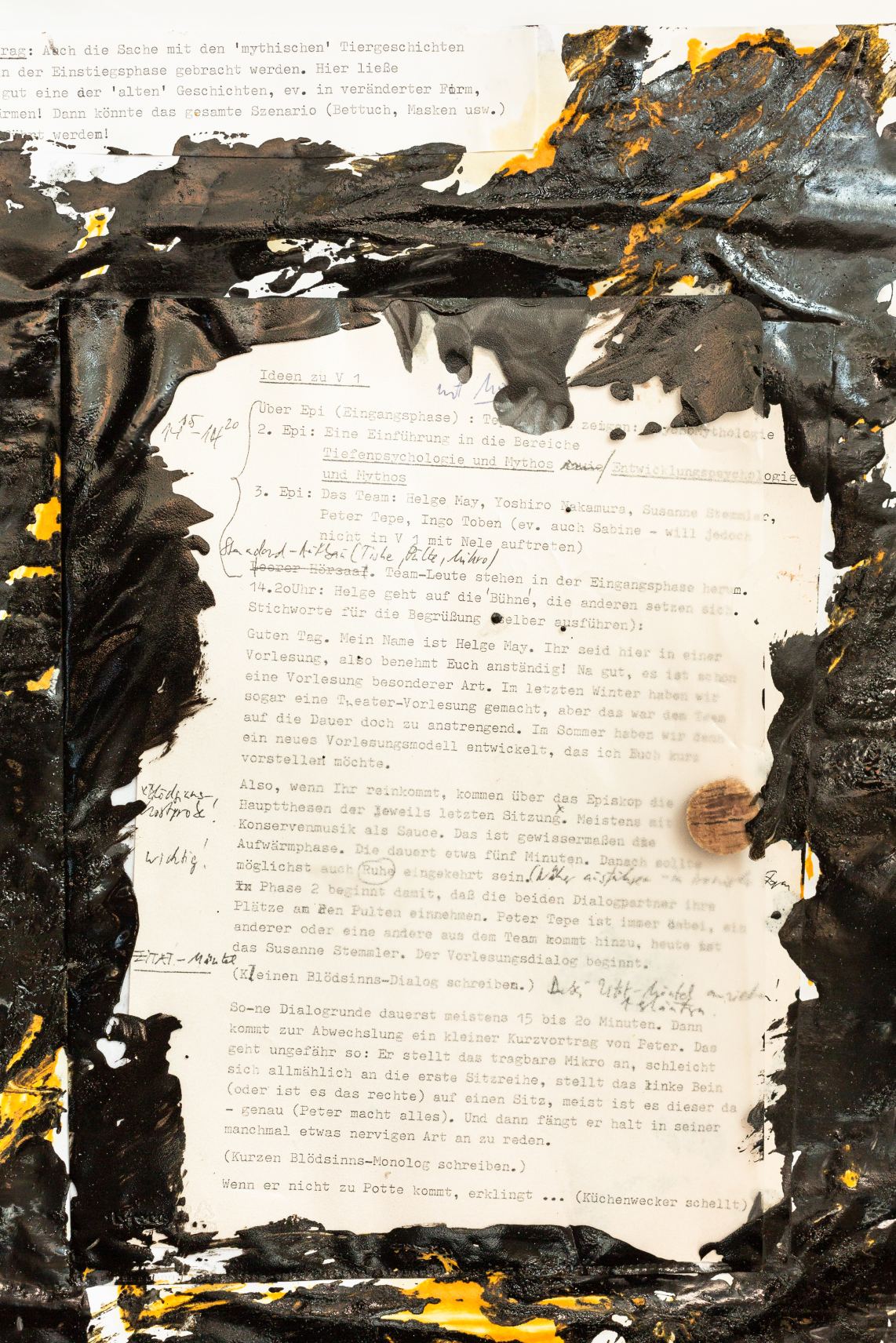
So far, series 2 comprises 19 works in A4. It is classified as art-related science because, in general, it is about the use of artistic means (in the broader sense) in scientific lectures and, in particular, about a retrospective reworking of the typewriter scripts that had been compiled in the context of the dialogical lectures, which still preserve the texts’ legibility.
Series 3: Special connection between science and art
At the end of 2018, in my spare time I began going through the works on paper I had compiled over previous years, adding respective titles and my signature on the reverse sides. This made me realise that I was no longer happy with several pages. I tried a number of methods for revising them – one of them being as follows: I cut out important theses from overhead transparencies (or their hard copies) that I had used in lectures on cognitive hermeneutics and ideology research, and incorporated these in the image. This created a direct connection between my scientific practice and my artistic activity.
One example of such a reworked piece:

Following on from this, in early 2019 I made two new, bigger works which incorporated this mode of combination from the outset. The photo of one of these works serves as the title image – here is another:

Series 3 is never about scientific illustration, i.e. about using artistic means (in the broader sense) to visually elucidate scientific theses or research results, but rather about playfully combining my painting with theses from theories I myself have developed. For this reason, I assign series 3 to science-related art: comprehensible scientific theses are integrated into an artwork, which in turn does not primarily aim to communicate the respective thesis. So far, series 3 consists of seven works on paper in various formats.
Series 4: Typewritten excerpts as a point of departure
To introduce series 4, I’ll start with a brief recap. During my studies at the Kunstakademie Düsseldorf and later at university, I began to produce many handwritten excerpts of predominantly philosophical texts.
Not only did I read a great deal, but I also always strove to delve deeper into the respective realm of thought that I often found difficult to access, by copying out in detail passages that seemed significant to me – first by hand and later on a typewriter. This was my chosen approach to learning, which I followed almost instinctively.
Over a longer period of time I grappled predominantly with the difficult writings of Kant, Fichte, Schelling, Hegel, as well as 20th century philosophers. The handwritten excerpts later became the basis for several artistic works I have created since 2013. For example:

Back to 2019: as I was clearing out, I came across many boxes filled to the brim with typewritten excerpts for various research projects. To begin with, I wanted to immediately bin this great heap of paper – as I had done previously with the anthologies for lectures and seminars, or with the leftover texts from students (final and seminar papers as well as protocols). However, thanks to a new idea which in its initial application immediately proved motivating, I changed my mind. This led to the following approach in my work:
- I endeavour to quickly skim through all excerpts, one by one – which might possibly take several years. If an excerpt fails to move me in any way, if it says nothing at all to me, then I will throw it away; you can’t keep everything.
- If, by contrast, a sentence or a passage somehow stimulates a thought process, I will cut out this passage and stick it onto an old piece of A4 paper, whose reverse side has already been used for other purposes. (Even for typewritten excerpts made since the 1970s, I mostly used the backs of earlier texts and copies.)
- In my studio, I then spontaneously write a short comment on the chosen, glued-in excerpt element using an old fountain pen that I rediscovered after decades, which because it leaks a bit, has to be held with a glove. The comment establishes a connection to one or another aspect of my current thinking.
- Prolonged reflection and changes in content are not allowed under my rules; corrections are carried out on the page. (While clearing out my office I then came across two more fountain pens that I hadn’t used in decades. I use them for writing comments on excerpt snippets either at my desk at home or while travelling.)
- My artistic approach here corresponds to the one employed in series 2: using up leftovers, speedy production and retrospective changes not allowed.
- In some of the works I also incorporate the reverse side of the page by letting it show through or making it visible by cutting it open/folding it over.
I am deeply touched by this approach, because it creates a direct connection between the artistic and scientific sides of my personality. I then sort the finished sheets according to different topics. I could imagine making a philosophical-artistic book out of them – but whether or not I can make this project happen remains to be seen.
Series 4 has a special focus: the cut-outs and my handwritten comments are to be read and understood – that is the main thing. A work like this does not primarily represent an aesthetic-artistic object whose reception allows the content or meaning of incorporated written elements to be ignored. Nonetheless, an aesthetic approach of this kind can and should follow. This distinguishes series 4 from series 1. In series 1, the respective content plays a minor role – or even none at all. There, I employ a text of my own that I previously used for a lecture as a point of departure for artistic projects, without making content-related references to this text and without wanting to convey its ideas.
Due to its central focus on the respective written comments, I assign series 4, as I did series 2, to art-related science: much as I used theatrical form as a vehicle for a lecture introducing research on myths back in 1993/94, I now employ handwritten comments and artistic annotation as a means of conveying – with regard to my cut-outs from old typewritten excerpts – my thoughts on philosophy, literary theory and other topics. In both cases, these are scientific activities that are allied to artistic concepts/methods/results. However, in one way series 4 differs to the Vorlesungstheater and the subsequent dialogical lectures referred to in series 2: here, from the outset, the science-art connection does not occur in the context of teaching (and then in the academic publication), but rather in an artistic context. Hence, art-related science need not always be embedded directly in a teaching or research context.






So far, series 4 comprises 77 works in an A4 format. It can be said that series 3 unintentionally paves the way for series 4.
The following w/k articles explore this topic further:
- Border Crosser between Science and Visual Arts. Here I recall my scientific and artistic development as well as the connections between the two dimensions. Several phases of my artistic work are documented in images.
- In the reports on the first and second w/k exhibition, the photo series by Karsten Enderlein also include images of my own artworks exhibited there. Additionally, the report on the first exhibition features a video interview with me.
- The article Points of Contact, written on the occasion of the passing of Karl Otto Götz, explains, among other things, the reasons for my move from the Kunstakademie to the University.
Picture above the text: Peter Tepe: Series 3, no. 5 (2019). Mixed media on paper (101.5 x 71.5 cm). Photo: Mauritz Tepe.
[1] P. Tepe: Mythos – Ideologie – Illusion. In: P. Tepe/M. Küppers (eds.): Mythologica 3. Düsseldorfer Jahrbuch für interdisziplinäre Mythosforschung. Essen 1995, pp. 60–77.
[2] Further information available in P. Tepe: 25 Jahre Schwerpunkt Mythos, Ideologie und Methoden … und kein Ende, chapter 15.3: Dialogische Vorlesung, pp. 39–42. In: Mythos-Magazin.
Translated by Rebecca Grundmann.
How to cite this article
Peter Tepe (2022): Science-Related: Four New Series. w/k–Between Science & Art Journal. https://doi.org/10.55597/e7460
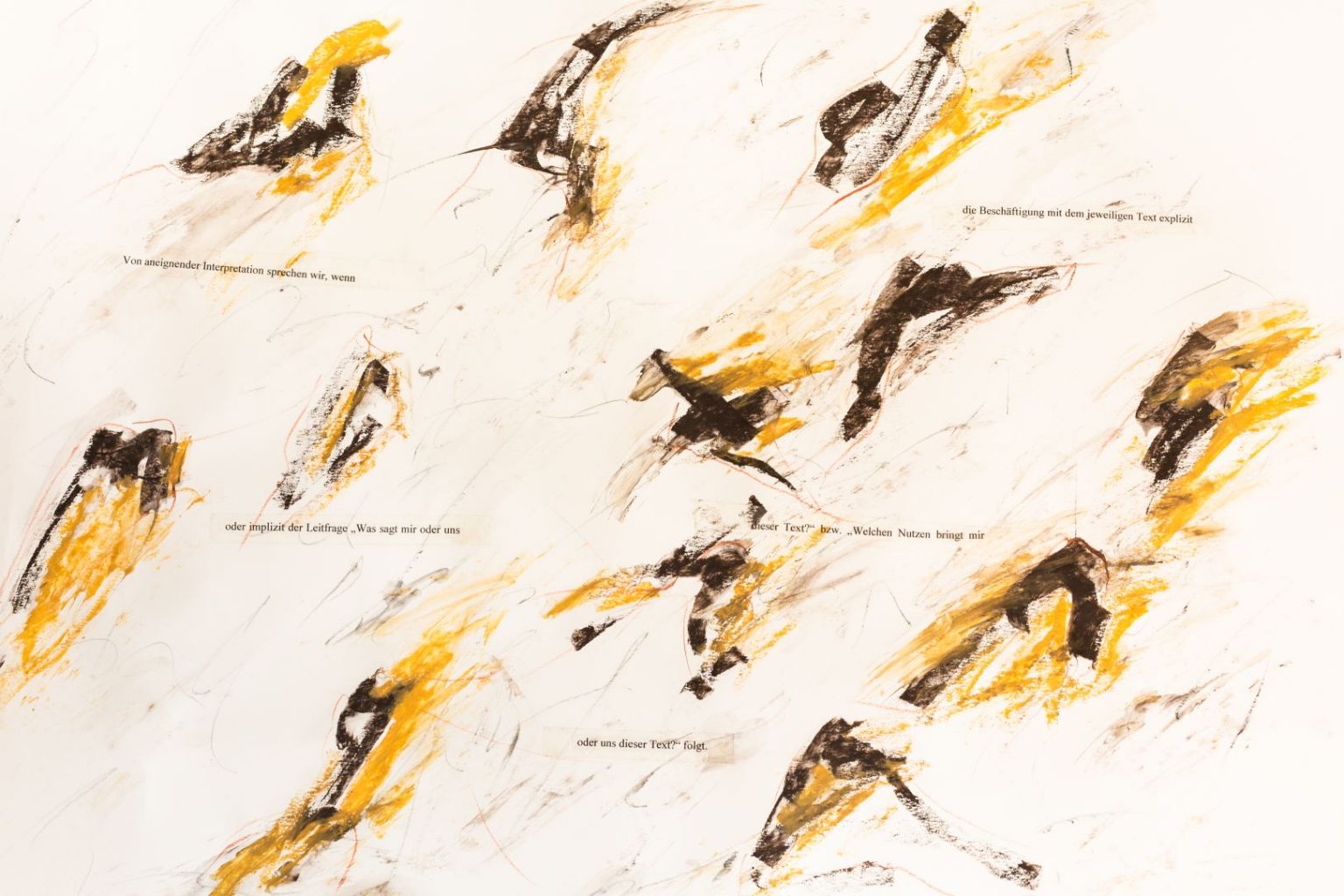
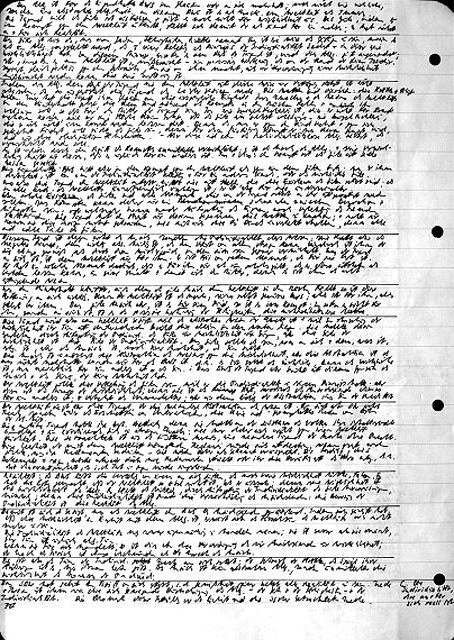

Be First to Comment